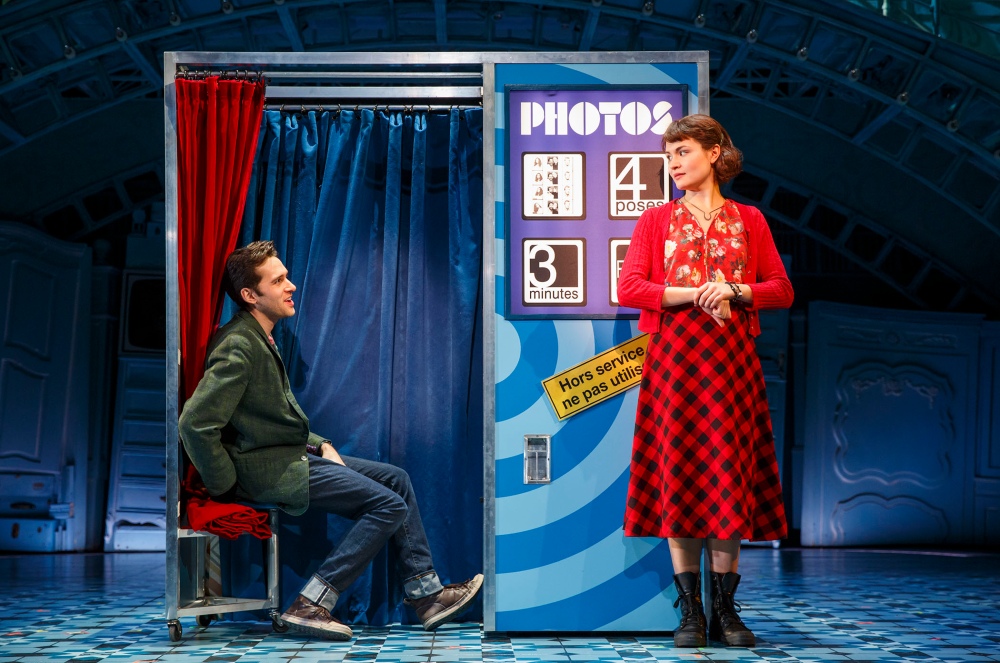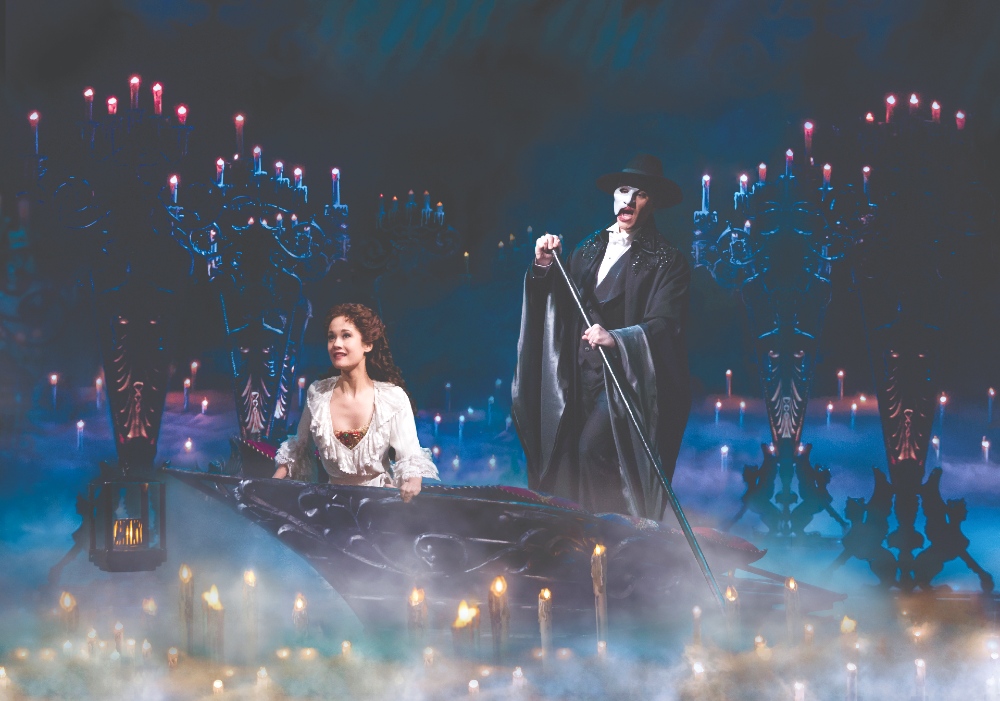Broadway adapted the English comedy The Captain’s Paradise in 1958, reproducing the general plot – a ferry captain torn between his wife and his mistress – while changing the setting. Instead of Gibraltar, his wife lived in London, and his mistress in Paris. “Setting the plot in Paris will automatically ramp up the temperature, the sexual quotient of the show,” says Laurence Maslon, who teaches dramatic arts and the history of musicals at the Tisch School of the Arts in New York. “Gibraltar and North Africa would have meant nothing to Americans, whereas Paris meant extramarital affairs on the banks of the Seine!”
The show’s poster clearly reflects this fantasy, featuring a young woman at a stove wearing nothing but a striped apron, heels, and a sailor cap. With its scenes in Montmartre, jazzy tunes sung in franglais (“Hey Madame!”), and its scantily clad dancers, this musical falls into the “tired businessman’s show” category. A simple, sexist formula, but one that worked. Oh, Captain! (the adapted title) stayed on Broadway for 192 shows and was nominated for the Tony Award for Best Musical.

Any theatrical show is a form of caricature. And this is even more the case on Broadway, where audiences should be able to clearly identify the time period and the main characters within the first 20 minutes. The opening song sets the tone. An American in Paris, the musical adaptation of Vincente Minnelli’s movie, opens with a U.S. soldier standing to attention in front of the Arc de Triomphe. Gentlemen Prefer Blondes, a show about two young American women travelling to Paris, begins with a dance on the deck of the Ile-de-France ocean liner. The crew weighs anchor and breaks into “It’s High Time,” in which “France” is rhymed with “transatlantic romance.”
Anna Held, Broadway's Femme Française
The love affair between Broadway and Paris dates back to the late 19th century. The French capital was at its peak, with art galleries, fashion boutiques, and cabarets drawing an international crowd. In 1896, the American impresario and producer Florenz Ziegfeld Jr. succumbed to the charms of a 24-year-old Franco-Polish dancer named Anna Held. Her bawdy songs caused a scandal in Paris and London where she performed bare-legged on stage – unheard of at the time! Ziegfeld convinced her to come with him to New York, where the vaudeville and theatrical revue shows had combined to create the musical comedy genre. Anna Held starred in eight productions between 1897 and 1908, and became a millionaire. Her role remained the same in The French Maid, La Poupée, Mam’selle Napoleon, A Parisian Model, and Miss Innocence – that of a 20th-century French woman, elegant, seductive, and sophisticated.
According to Laurence Maslon, at the time “Paris was the most elegant, theatrical, sophisticated venue on the planet.” But also the most scandalous. In the third act of The Merry Widow, the show to watch in 1907, a row of dancers in frilled dresses sang a chorus that has remained in the collective memory: “We are Maxim’s greatest glories, and we’re here to welcome you, we’re the little Paris ladies.”
A Parisian Setting
From one Broadway musical comedy to the next, the French were portrayed as cheats, cowards, unfaithful, and debauched. “This is what we call a ‘free pass’ in the business,” says Laurence Maslon. France was a pretext, with the French characters portraying everything hidden, repressed, and censored by American morals. In South Pacific (1949), an Arkansas-born nurse falls in love with a rich, French plantation owner. She then leaves him when she discovers he has two mixed-race children with a dark-skinned Polynesian woman.
In Irma La Douce, presented in Paris in 1956 and performed in New York from 1960 onwards, audiences follow the life of a Parisian lady of the night. Set to music by Marguerite Monnot, one of Edith Piaf’s songwriters, this show was the first real French hit on Broadway. It was also the first time a prostitute was the main character. And “it worked because it was French,” says Patrick Niedo, a former dance teacher in New York and the author of two books on U.S. musicals. “The Americans see infidelity, curse words, and prostitution as part of Parisian folklore.”
Porter, Gershwin, and Hammerstein Revamp the Parisian Image
However, not all musicals presented the same stereotypical image. Three American composers differed in their representation of Parisian life. The most distinguished of the trio, Cole Porter, lived in France from 1917 to 1937. His songs made no mention of Montmartre or the florists on the Grands Boulevards, but rather the winter rain and the heat of the summer (“I Love Paris”). In Fifty Million Frenchmen (1929), the song “You Don’t Know Paree” became a classic in the American show tune repertoire. “You come to Paris, you come to play,” wrote Cole Porter. “You may know Paris, you don’t know Paree.”
George Gershwin and Oscar Hammerstein II had the same message for their fellow Americans, showing that Paris was more than a collection of clichés. The former spent two years in France before writing his renowned concerto, which was featured in a musical in 2014. The latter composed “the greatest song ever written about Paris,” according to Laurence Maslon. Hammerstein was shocked to learn of France’s surrender in 1940, and his “The Last Time I Saw Paris” is an homage to the City of Light. Filled with nostalgia, he remembers the “squeaky horns” of taxis, “Punch and Judy in the park,” and the trees “dressed for spring.”
The End of Ouh La La
The way France was represented on Broadway changed in the 1960s. The jet plane encouraged transatlantic relations and sex was no longer a taboo confined to the Pigalle neighborhood of Paris. The trend of racy “ouh là là shows” petered out and productions stepped up their game. In 1969, American movie star Katharine Hepburn played Gabrielle Chanel in the biographical musical comedy Coco, a Hollywood-backed blockbuster show. With a budget of 900,000 dollars, it was the most expensive Broadway production at the time. The final scene featured a fashion show with Chanel outfits from 1918 to 1959, and saw Cecil Beaton win the Tony Award for Best Costume Design. French actress Danielle Darrieux then replaced Hepburn in the leading role in 1970, but failed to win over American audiences.

France was in the spotlight once again in 1983 when an English musical version of Jean Poiret’s play La Cage aux Folles was presented in New York. The show portrayed transvestite dancers in a cabaret in Saint-Tropez and was met with rapturous applause. It remained on Broadway until 1987 and the song “I Am What I Am,” later covered by Gloria Gaynor, became an anthem for the LGBTQ community. In another vein, the musical comedy Sunday in the Park with George (1984) payed homage to Georges Seurat. Composer Stephen Sondheim drew inspiration from the painting A Sunday Afternoon on the Island of La Grande Jatte exhibited at the Art Institute of Chicago to present the Pointillist master’s career. The show won the Tony Award for Best Scenic Design, and in a rare turn, also picked up the Pulitzer Prize in the Drama category.
The Adaptation of French Classics
“Musical comedy is a typically American show genre,” writes Patrick Niedo. Although this did not stop directors from drawing inspiration from French culture to create new productions. There were many adaptations of French books, plays, operas, and movies, including The Three Musketeers (1928), Candide (1956), Cyrano (1973), Madame Bovary (2013), and Amélie (2017). The show Into the Woods (1987) combined several tales by Charles Perrault, while Carmen Jones (1943) took Bizet’s Carmen and set it in an African-American ghetto of Chicago.
In 1987, Gilbert Bécaud teamed up with American producer Harold Prince for the adaptation of The Life Before Us, a Prix Goncourt-winning novel by Romain Gary published under the pseudonym Emile Ajar. A previous cinema adaptation starring Simone Signoret as Madame Rosa won the Oscar for Best Foreign Language Film in 1978, but the musical version was a flop. Roza lasted just 12 shows before being cancelled.
"The Broadway Powerhouses"
It was an English producer named Cameron Mackintosh who actually gave France its biggest Broadway shows. Les Misérables was the fifth most popular musical in the United States, and was performed 6,680 times between 1987 and 2003. And The Phantom of the Opera has had eight shows per week at the Majestic Theatre since January 26, 1988! No other production has enjoyed such longevity.

This was the heyday of “Broadway powerhouses,” according to Patrick Niedo. The Phantom of the Opera had a budget of eight million dollars, and the chandelier and basements at the Opéra Garnier along with the Belle Epoque costumes portrayed in Gaston Leroux’s novel were all identically reproduced. The show won six Tony Awards, including one for Best Musical, and was seen by 18.5 million people in New York alone! To date, it is the most popular show in Broadway history.
Les Miz, a Global Success
The musical adaptation of Victor Hugo’s novel – known as Les Miz to U.S. audiences – enjoyed a similar reception. The stage was occupied by a barricade over 16 feet high comprised of planks, timber, chairs, and barrels, representing the Paris Uprising of June 1832. When the troops opened fire in the middle of the second act, performers in tricolor scarves fell back over the barricade. Audiences filed out of the theatre humming revolutionary anthems such as “Do You Hear The People Sing?”

Purists accused the production of overly simplifying Victor Hugo’s work. “It would have been madness to try to condense a 1,500-page novel into a three-hour show,” says Patrick Niedo. “They had to make choices, depict epic events, intimate scenes, and moments of joy and sadness.” The show originally created by Claude-Michel Schönberg, Alain Boublil, and Jean-Marc Natel at the Palais des Sports in Paris has since been translated into 21 languages and watched by 60 million people in 42 countries. Les Miz started an American tour in October 2018 that will run until August 11, 2019, proving that Victor Hugo still has a loyal following in the United States.
Article published in the December 2018 issue of France-Amérique. Subscribe to the magazine.












